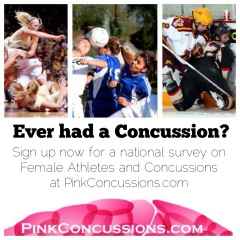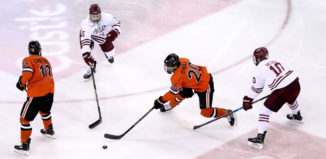Pink Concussions: Study Explores Head Injuries in Female Athletes
There’s nothing like the pain of a concussion: a headache so bad, it’s vomit-inducing, and sensitivity to light and sound that can force isolation for weeks or months, sparking depression and anxiety.
Concussions have physical and emotional affects on all athletes, but Katherine Price Snedaker is spearheading research to look at female athletes’ experiences with concussions. She is hoping to use the research as a push for more education about head injuries in sports and a cultural change in the way concussed athletes are treated.
The study is an online survey for females 18+ who have had head injuries related to sports. Almost 350 women have already signed up to take the survey.
“I had concussions as a teenager, between sports and car accidents, and I was taken to the ER with headaches but nobody told me anything about concussions. I lived with that and in my 20’s, I noticed I kept getting concussions and when other (women around me) weren’t,” said Snedaker.
Then Snedaker’s son, who is in sixth grade, received a concussion during recess that kept him out of school for almost four months. But they didn’t stop – he received a number of additional concussions once returning to normal activities, and Snedaker became worried. His personality was flat, she said, and so she did research on the injury.
Snedaker, who has coached lacrosse and soccer, became passionate about concussion education and started clinics to teach parents, coaches and athletes about traumatic brain injuries.
In 2012, Snedaker who has a Masters Degree in Social Work, ran a post-concussion (support) group for teens through The Concussion Specialists of Connecticut. “In this group, 13 of 15 teens were girls,” she said. “And the the girls seemed much slower to heal, many had had repeat concussions, and all were isolated from their friends. Studies have shown girls take longer to recover from concussions. The dirty secret is some of us who get (concussions) as kids continue to have them throughout our adult lives. People have this fantasy that if they leave their sport, they don’t concuss anymore. It’s not always like that.”
So Snedaker launched PinkConcussions.com and consistently tried to update it with research relating to concussions in female athletes – except, there wasn’t much research being done.
She took to social media and connected with Dr. Jimmy Sanderson and Dr. Melinda Weathers, two researchers from Clemson University, and inquired about doing a study on the topic by posing questions to a general population of female athletes.
“The NFL is paying researchers to look at concussions (in football players), so that’s what researchers are doing,” she said. “There’s no money to be made in researching concussions in female athletes but we are hoping this will generate interest.”
Snedaker hopes to learn more about females’ experiences after being diagnosed with a concussion, reporting their concussions or playing through the pain. She also hopes to learn more about the emotional affects of the brain injury.
“There is new research being done with male football players and suicide relative to concussions, depression and alcohol,” she said. “We haven’t done the research to see how girls’ experience of concussion differs. I think girls are very social and struggle with the isolation. If they cannot text or go to the movies, school or their sport, it can be very depressing for many teenage girls recovering from concussions.”
In the future, Snedaker hopes to spearhead more research exploring many different aspects of concussions in female athletes. In the mean time, she will also continue to speak about the importance of education on the topic and implementing educational programs for coaches, parents and athletes.
“I would like concussion education to be like swimming lessons. We don’t call them drowning lessons…You reach a certain age and that’s just what you do. We don’t want you to drown. I think there should be an education piece as part of a curriculum in health where kids, parents and coaches learn about it, ” she said. “And it’s for every kid, not just athletes. Both active and non-active kids.”
Snedaker said she’s hoping the education can help people recognize concussions and learn how to manage them. She’d like to see more girls playing hockey, soccer, and other contact sports – with the right training on head injuries.
“I want more kids playing sports because when you have coaches and referees, you are more likely to get concussion care if you get hurt in a sporting event rather than in your back yard,” she said.
Snedaker also wants to help those who have felt isolated due to their concussions.
“People don’t know how to support people with head injuries, so I want to reach out and talk about how we can help these families as a community. That’s how I sell it to parents: someone’s kid is going to get a concussion; how can you help the person sitting next to you?”
The survey will be live through Oct. 31 and Snedaker hopes to reach at least 1,000 women. Women from any country can take the survey. Participants can also agree to stay in contact with the organization for future possible studies.
For more information on the survey and concussions in female athletes, click here.














